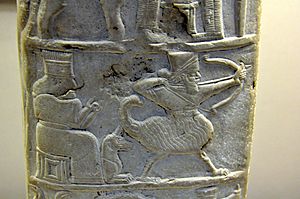Nebuchadnezzar I facts for kids
Quick facts for kids Nebuchadnezzar I |
|
|---|---|
| King of Babylon | |

Detail of the goddess Gula, her dog, and a scorpion man from kudurru of Nebuchadnezzar granting Šitti-Marduk freedom from taxation. British Museum.
|
|
| Reign | c. 1121–1100 BC |
| Predecessor | Ninurta-nādin-šumi |
| Successor | Enlil-nādin-apli |
| House | 2nd Dynasty of Isin |
Nebuchadnezzar I (also spelled Nebuchadrezzar I) was a powerful king of ancient Babylon. He ruled for about 22 years, from around 1121 to 1100 BC. He was the fourth king of the Second Dynasty of Isin and the Fourth Dynasty of Babylon.
Nebuchadnezzar I is most famous for his great victory over the land of Elam. He also brought back the important statue of the god Marduk to Babylon. This statue had been taken by the Elamites.
Contents
Who Was King Nebuchadnezzar I?
Nebuchadnezzar I was different from the later, more famous Nebuchadnezzar II. The later king is mentioned in the Bible. Our Nebuchadnezzar I was not in the Bible.
He followed his father, Ninurta-nadin-shumi, as king. After him, his son Enlil-nadin-apli became king. His brother Marduk-nadin-ahhe and nephew Marduk-shapik-zeri also ruled later. These were the only family members known to be kings in this dynasty.
Ancient stories say that the god Marduk gave Nebuchadnezzar I great wisdom. These stories also claimed he came from a very old line of kings. They said his family was important even before a great flood.
Why Was Babylon in Trouble?
Before Nebuchadnezzar I became king, Babylon faced hard times. The land was suffering, and evil seemed to be everywhere. The gods were thought to be angry and had left the land. People started doing bad things.
Evil spirits were believed to fill the land. The country became weaker. Then, the people of Elam attacked Babylon. They did not care about Babylon's treasures. The Elamites destroyed homes and took away the statues of the gods. This was a very sad time for Babylon.
War with Elam
We don't know exactly how long Nebuchadnezzar I fought Elam. We also don't know how many battles he led. But it seems like it was a long and difficult war. One story says his army got sick with a plague. He barely escaped with his life.
However, he did lead a very successful attack. This attack is recorded on a special stone monument called a kudurru. In this attack, he was joined by a Kassite leader named Šitti-Marduk. They launched a surprise attack from the city of Dēr. This happened during the hottest summer month, Dumuzi.
The kudurru describes how hot it was:
- The axes in their hands felt like fire.
- The roads were burning hot.
- There was no water in the wells.
- Drinking water was hard to find.
- Even strong horses became weak.
- The legs of the strongest men tired easily.
Despite the heat, Nebuchadnezzar I defeated the Elamite king, Ḫulteludiš-Inšušinak. The battle took place near the Ulaya river. The dust from the fighting made the sky dark.
Nebuchadnezzar I did not destroy the Elamite city of Susa. But he did get back the statue of the god Marduk. He also brought back the statue of the goddess Il-āliya. This victory was a huge moment for the Babylonians. It was like a very important story for them, similar to the story of the Trojan War for the ancient Greeks.
Celebrating the Victory
This famous win was celebrated in songs and poems. One poem, called "Nabû-kudurrī-uṣur and Marduk," tells the story of how he brought Marduk's statue home. It starts with the king feeling sad because Marduk was gone. He asks Marduk to return to Babylon.
Another song, the "Hymn to Marduk," also celebrates this victory. It praises Nebuchadnezzar I for his military success. These writings show how important this win was to the people of Babylon.
Other Conflicts and Achievements
Nebuchadnezzar I also had conflicts with the Assyrian king Aššur-rēša-iši I. At first, they had a friendly agreement. But Nebuchadnezzar I attacked some border forts. The Assyrians fought back. In one battle, Nebuchadnezzar I had to burn his war machines and run away. In another battle, the Assyrians won. They defeated his troops and captured his camp.
The kudurru stone also calls him the "conqueror of the Amorite lands." It says he "despoiled the Kassites," even though his ally Šitti-Marduk was a Kassite leader. He also defeated the Lullubû people in battle.
Building Projects
Nebuchadnezzar I was also involved in building projects. He built the Ekituš-ḫegal-tila temple for the god Adad in Babylon. He also worked on the temple of Enlil in Nippur. A later king, Simbar-shipak, mentioned that Nebuchadnezzar I built the throne of Enlil.
Some old records show that he gave gold vessels to the city of Ur. Another king, Nabonidus, looked at a stone monument from Nebuchadnezzar I's time. This shows how important Nebuchadnezzar I was even centuries later.
Daily Life and Records
Only a few records from his time tell us about daily life or business. These include three kudurrus and a stone tablet. They show things like land being given to a priest in Nippur. His name also appears on some bronze daggers found in Lorestān. There are also prayers to Marduk on two other daggers.
Some historians believe that during his reign, Marduk became the most important god in Babylon. He took the place of the god Enlil. It's also thought that a famous Babylonian creation story, the Enûma Eliš, might have been written around this time.
Images for kids
See also
 In Spanish: Nabucodonosor I para niños
In Spanish: Nabucodonosor I para niños
- Kudurru for Šitti-Marduk
- Neminath



